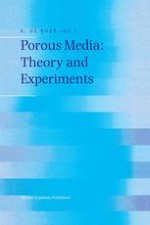1999 | Buch
Über dieses Buch
The EUROMECH Colloquium 366, 'Porous Media - Theory and Experiments' was held at the Bildungszentrum fiir die Entsorgungs-und Wasserwirtschaft GmbH B·E·W, Essen, Germany, from 23 to 27 June 1997. The goal of EUROMECH 366 was the presentation of recent findings in the macroscopic porous media theory (mixture theory restricted by the volume fraction concept) concerning general concepts and special investigations in the theoretical as well as the experimental field. Herein, numerical results requiring new solution strategies were also to be included. Moreover, foundations of fundamental state ments in the macroscopic porous media theory (e.g. the effective stress principle for incompressible and compressible constituents by micromechanic investigations) were welcome. Emphasis was placed upon the need to bring together scientists from various branches where porous media theories playa dominant role, namely from theoretical mechanics, agriculture, biomechanics, chemical engineering, geophysics and soil mechanics as well as from petroleum energy and environmental engineering. More than 80 people from 12 different countries expressed their interest in the Colloquium, and finally, 58 took part in the meeting presenting 42 papers. Among the talks were seven principal lectures given by leading scientists in the a.m. fields invited by the organizers. As Chairman of EUROMECH 366, I would like to thank the co-chairmen and all of my co-workers from the Institute of Mechanics, FB 10, University of Essen, for their help in organizing the Colloquium, in particular, Dr.-Ing. W. Walther, Priv.-Doz.
Anzeige
